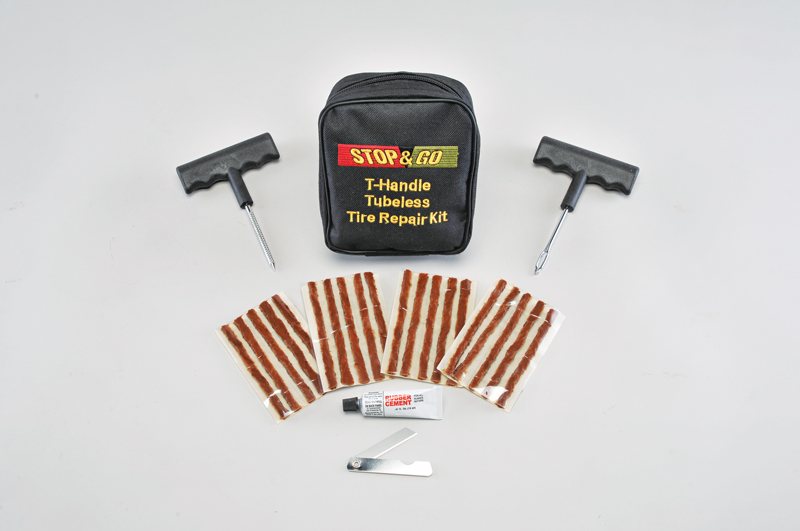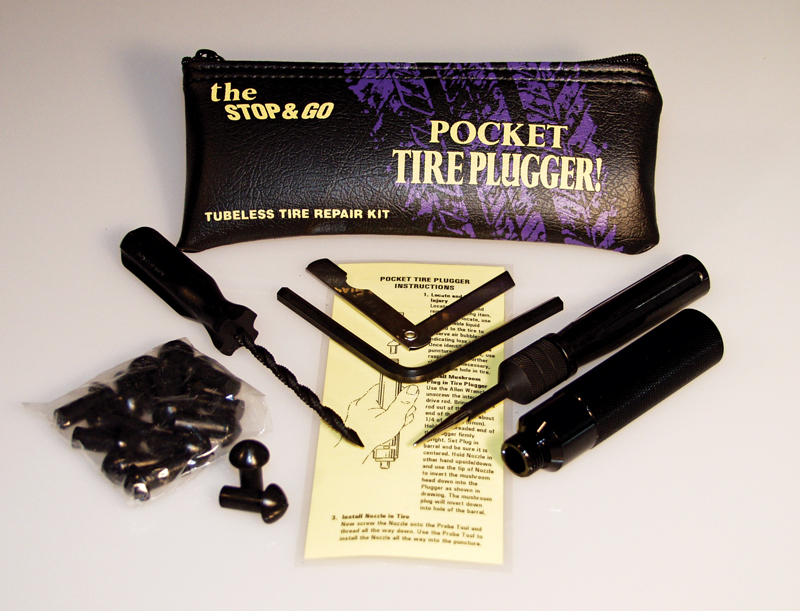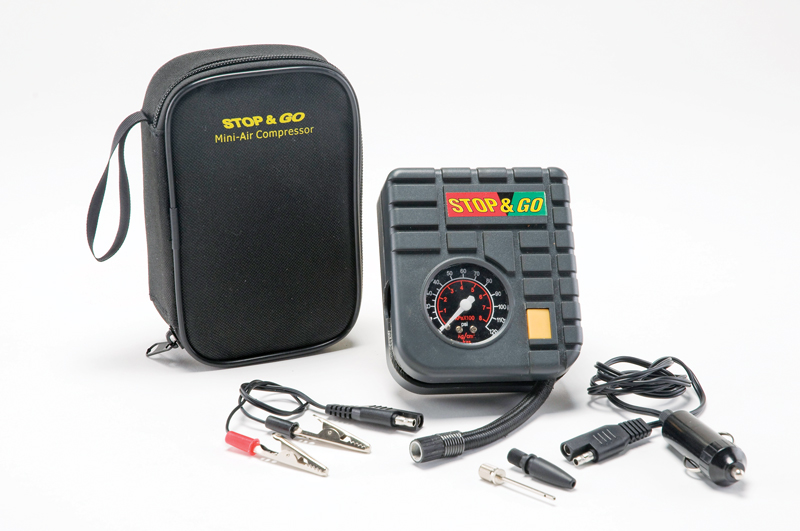
Considering how bulletproof the rest of our motorcycles have become, it’s ironic that it only takes a little 1 ½-inch box nail in a tire to bring the whole show to a halt. We’re fortunate today that tubeless tire technology prevents intrusions by nails, screws and other foreign objects from becoming catastrophic blowouts. The object usually stays in the hole, the only place from which the tire can lose air, so it deflates more slowly than a puncture in a tire with a tube on an unsealed spoked wheel (which can lose air through all of the spoke nipples and even the tire bead). But even if that pointy thing does stay put and flush with the tread surface, as it flexes back and forth in the carcass the tire will eventually deflate enough to become a problem. Hopefully you will have noticed its presence or even received a low tire-pressure warning before that happens.
Of course, if it doesn’t stay put or is large enough to stick out of the tire (like a 6-inch gutter nail — don’t ask), the tire will probably deflate rapidly enough to strand you by the roadside. Unless you’re lucky enough to be next to a motorcycle shop at the time, you’re going to need either a good roadside assistance plan or a tubeless tire repair kit. (We’ll cover tube-type tire roadside repairs in another installment).





Here at Rider we’ve fixed enough tubeless punctures to appreciate that the most dependable tire repair kit you can carry uses rubber strings or “worms” for the plug that gets inserted into the tire, preferably the large red ones like those in the T-Handle Tubeless Tire Repair Kit from Stop & Go. There are more convenient plug types, but the strings rarely let us down. If you’ve had good luck with liquid sealers, installed either pre- or post-puncture, more power to you — we often carry Slime for tube-type tires on bikes that have tubes in the hope of avoiding a roadside tire dismount. But we change bikes too often to make using the pre-installed sealers practical, and prefer to avoid irritating the mechanic who has to change a tubeless tire on a wheel full of messy sealer.
Repair kits that use string plugs often come with rubber cement, which — depending on the string type — may not be necessary to complete the repair, but at a minimum it acts as a lubricant to ease inserting the plug, and seems to help vulcanize the plug to the tire. It’s important to keep your glue supply fresh (preferably unopened), or you may find that it has dried out when you need it.



No matter what sort you use, any plug inserted from the outside should be considered a very temporary repair used to get you and your bike to the nearest replacement tire. Limit your speed per the plug kit instructions, and replace the tire as soon as possible. Special patch plugs inserted from the inside of a tubeless tire are certainly safer, but even if you can find someone who will install one for you, every tire manufacturer (and even those who sell patch plugs) recommend replacing the tire instead since it has to come off anyway.
The photos in this article cover the basic plugging process with rubber strings. Depending on the size of the hole, you may need more than one — I once used three in an ATV tire and it got me back to camp.








Looks like an ad for Stop and Go…
The difference between an advertisement and a recommendation is that an ad says whatever the sponsor chooses and is clearly biased in the sponsor’s favor. A recommendation reflects the source’s independent experience and judgment, which should be considered in light of the source’s experience, reputation and objectivity — in particular whether the giver of a recommendation is “compromised” by any relationship with the product manufacturer.
Ad or not, it is very informative!
I used a patch plug in a new tire(less than 250 miles) on my Harley and put another 20,000 miles on it with no problems
I’ve never gotten 20000 on a tire on my harleys however I did plug one, roughly 1000-1200 miles, and road it till time for new tire at roughly 9000 miles and like you no problem.
I own five Harley`s and one Honda GoldWing. 0n the Harley`s the highest mileage was in the 10 to12 thousand miles. The Honda get much better mileage.
I’d love to know what kind of tire you got 20,000 miles out of. I’ve never got more than 9000 miles out of any tire on my Harleys.
He didn’t say if it was the front or back tire. 🙂
Just an FYI from a recent tire plugging experience I had. No telling how long I have had the string plugs for the repair I recently did. It wouldn’t surprise me if I have had them for 15 years or longer. They were even like the red ones in the article. I plugged a rear tire just about step for step as the steps outlined in the article. A few days later I discovered the tire had a slow leak at the plug and wasn’t holding air. Long story short, I decided to install a second plug next to the first one. However, this was from a different set of string plugs I had on hand. (black plugs, not that the color makes a difference but stating that fact for identification) What I immediately noticed on the second plug (black) when it came out of the package was that it was stickier and had more ‘goo’ on it than the first one I had installed. I don’t know how long I have had them either but it wasn’t as long as I have had the red plugs. The black plug had more ‘goo’ to the extent that I realized that compared to the red plug you could say that the red plug, even though still somewhat sticky, it was ‘drier’ than the second plug (black) and not near as sticky and gooey. With the second plug installed next to the first the tire held air. I can only surmise that the first plug (red) had indeed dried out somewhat in all those years it has travelled in my tool kit and lost its effectiveness and ability to completely seal a puncture. So the good news was that over the years I have very few flats to deal with as evidenced by the number of string plugs I had on hand. The revealing news according to my completely unscientific hypothesis was that apparently string plugs can dry out somewhat over the years and lose their effectiveness and ability to seal a puncture. So it’s probably not a bad idea to check any string plugs that you have had on hand for years and years and see if they may have dried out to any extent.
Hmm. Thanks for the input. Makes sense. At any rate they are to cheap not to replace once in a while.
Long story short?
Great time for this reminder with serious riding season coming. For those who carry the kits, but have never had to use them, it is a good tutorial review of the steps necessary to get back on the road when you can, assuming the tire was not damaged. A friend had that experience.
I’ve used those “string type” plug kits to get myself home, but for the long-term, I always replace that plug with the “umbrella type” plugs, that must be installed from the inside of the tire out. The mushroom-shaped plugs shown here look like a possible winner.
The Stop n Go plugs are also considered temporary. I had one pop out. However the gummy worms do a pretty good job and most have taken me to the end of the tire life.
Replace the tire asap…. POPPYCOCK! Run her down to the cords like any other tire. Unless you’re trying to set a new land speed record at Bonneville, of course!
Have been using the strings since they where first widely available. Both motorcycle & car. Don’t remember when that was. Started roadriding in ’61. Anyway, never replaced a tire because it had a plug. Frequently ran 100 -130mph (was young). Found 3 in a worn out cycle tire once that I didn’t even remember putting a plug in. Never had a problem.
I have used these plugs on my pick up, un the bush (oil field) and ran for months before switching to winter or summer tires respectively. They work amazingly, never had a problem. The guys I learned about them from had also used them in the same rough terrain and never had a problem. Anytime the tire shops see them they will fix the tires “properly” and tell you they did so, usually no charge, as that’s been my experience twice now. I have also helped out others with this style of patch, reports came back the same as mine, positive. I will buy a second kit and look into the co2 kit vs mini pump. This summer we are going state side for a Montana tour, going to be prepared!
In 20+ years of riding, I’ve never had a flat. But in two instances, I was able to help others with the Pocket Tire Plugger.
In the first instance, a couple was on a Gold Wing at a gas station with a flat. This happened in Utah about 2000 miles from our home in New Hampshire. I repaired their tire at a gas station with the pocket tire plugger. Don’t know how long the plug held or if they were able to buy a new tire quickly as we parted ways–they to their home in Washington and we to back home to New Hampshire.
The second instance was in Nova Scotia on a group ride. One of my buddies was on a rare Moto Guzzi. I repaired his flat and the repair held perfectly for thousands of miles and two weeks. The reason I know about the two weeks is because that’s how long it took Moto Guzzi to send a tire from Italy to my buddy’s home-dealership in Massachusetts. No tires for his bike were available in the US.
Lessons learned: The Tire Plugger works well and don’t buy a Moto Guzzi!
Yeah that’s the bike fault? More a crap dealer. He could have gotten a tyre from any bike dealer. FFS, stupid comment
Very timely – just two days ago I found my rear tire flat and a big nail in it. I’ve owned the stop and go kit with the mushroom plugs for over 10 years but never had occasion to use it. It took me a couple tries to get it in the tire, and once in it was still a slow leak but certainly held enough air in for me to ride to the shop. Well worth having!
I have used the Stop and Go kit several times with the Mushroom plugs on several vehicles. A Superb Product! Highly recommended. But their best package. Saved me multiple times!!
Practice before you need it…
Right before you are installing a new tire, puncture it yourself and practice fixing it. Better to learn what works under “ideal” circumstances than the side of road at night. You could even try a couple different holes and see which repair kit you like best.
Few notes…
If you are having a dealer replace your tire, practice there vs. your driveway. Much easier to push your bike across their parking lot than trailer from your house to the dealer.
Ask to look at the old tire so you can see what the plug (or plugs) look like from the inside.
Have your plugging kit “ready to go” prior to removing the nail, etc. You’ll want to plug the hole as quickly as you can so you lose less air.
I have used the mushroom plugs in the past with good results, however I always replace the tire as soon as possible.
I’ve had the Stop n Go mushroom pop out 3 of 3 times. Would suggest avoiding those based on my experience. Have had good luck with Dynaplugs. Have ridden 2 Dynaplugged rear tires (always seems to be in the first 1000 miles of a new tire) up to 200 miles with no loss of air but always replaced with new tire as soon as I could after the repair.
The trick with a Stop-N-Go mushroom plug is to pull the plug tight with a pair of pliers from the outside once you’ve inserted the plug to get the mushroom cap to seal on the inside of the carcass. The seller at any cycle rally will demonstrate for you on his scrap tire and explain that most mushroom plug failures are from not pulling the plug outward tightly after installing the plug per the directions. When installed properly, the mushroom plugs have been good for the life of the tire. On NJ toll roads you are not allowed to use your roadside assistance program service, so it is wise to carry a plug kit to avoid their legalized highway robbery service people on the NJ Turnpike, Garden State Parkway or AC Expressway.
I picked up a screw in a brand new tire on the way home from the dealer and used a DynaPlug with excellent results. Ran that tire for 9000 mi. with zero problems. Of course I inspected the tire & repair before every ride and maintained proper inflation always. That was 8 years ago and I still carry the kit even though I’ve only used it the one time. I do carry a Cycle Pump & gauge with me at all times.
I picked up a nail in a rear tire and plugged it with the black sticky string. It lost about 1 psi/day, so I always had to top it off before a ride but it got me through the life of that tire – probably another 8,000 miles or so.
I ride a heavy touring bike, Yamaha RSV. Been riding 50+ years. Traveled all over US & Canada. Been very fortunate with tires. But two years in a row, with new rear, I’ve had flats. I use Ride-On faithfully as I truly believe it prevents a blowout. The two flats I had, both times almost new tires, I discovered after the fact were major punctures. One looked like a piece of steel had cut a gash in the side wall. The next time, I found a hole size of my little finger in center or tire. I had been riding through a construction area on interstate, and suspect they had exposed a rebar rod from grinding off old pavement. I learned an RV lost three tires in that area. I was 30 miles from home on way to Texas.
But in both cases, even with large punctures, tire deflated slowly allowing me to ride few miles to place to get off highway. In both instances I wasn’t far from home, so called AMA Road Assistance for transport home, where I pulled the rear wheel and had it replaced by my tire dealer. I truly believe without the Ride-On I would have had a drastic experience with sudden deflation. And, it’s water soluble so not too mechanic unfriendly. If nothing else, Ride-On gives me some peace of mind. And no, I get no discount or favors for mentioning what works for me. Happy riding!
I’ve had four flats in one year before…always use the strings to get home, then pull the tire off and carefully install a patch/plug from the inside. Never had one that didn’t make it all the way to the cords.
To answer Tom Wiley, I have used Avon Venom’s on my Triumph Bonneville America and got 20.0000 miles on the rear, and 22,000 miles on the front. I have 58,000 miles on the America
I also have aTriumph Trophy SE and put Avon’s on it with very good results. Chuck G
Every plug in a tire reduces the speed rating one letter. Any external repair should be replaced by an internal repair as soon as possible.
Seems as if motorcycle tires “attract nails” is what my dealership shop manager told me. I had purchased a new motorcycle, and in the first service, they noted a nail in my rear tire. They quoted me a good price to change it out, but with 600 miles on the bike, I told them to leave the nail in the tire and I would try to plug it. For me…I needed the psychology of putting a few more miles on the tire before I threw it away.
Learned one thing – when putting a tire plug in, the secret sauce IS the rubber cement trick. Slides the plug in much easier, and will seal the hole a lot better. I ran that bike for thousands of miles after the repair, the rear tire held air better than the front! Also, be careful not to ream the hole too much, as I did that once and had to repair the tire with a patch on the inside of the tire.
I use a great system called MotoPressor 4-1 Puncture Repair Tool. It’s compact and all the tool you need are in a real small pouch that I carry on my belt.
I have just done my first two tubeless installs. Both went well. Thanks for sharing this useful article.